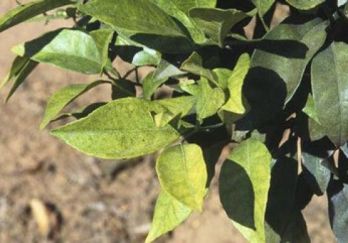Citrus red mite
Citrus red mite (Panonychus citri) is a member of the spider mite family, known to feed on a wide variety of citrus species.
Background
Citrus red mite was first recorded in Australia in 1966 at Oxford Falls, Sydney. It has since become established in metropolitan areas across the central coast region of NSW, mostly targeting orange trees. The mite has not been recorded elsewhere in Australia.
The citrus red mite biosecurity zone includes the counties of Cumberland and Northumberland, which restrict movement of pest host materials. See the treatment conditions for citrus, fortunella or poncirus for citrus red mite.
Impacts
Citrus red mite has around 90 species of hosts across 30 plant families, including orange, lemon, mandarin, tangerine and grapefruit. Murraya (orange jessamine) plants have been recorded as an alternative host for the pest.
The insects feed on leaves, preferring light green, maturing foliage. They also feed on green bark and fruit of any age. The scratch-like damage gives the leaves and immature fruit a pale appearance, while mature oranges and lemons turn a pale straw yellow.
In light infestations, citrus red mites attack the base of upper leaf surfaces. Trees under stress from mild dry winds and low soil moisture are more susceptible to heavy infestations. This leads to:
- defoliation starting in the tops of trees
- fruit drop
- twig and branch dieback.
Mites spread over long distances in clothes when moving infested plant material or equipment. Over short distances, they can walk between plants or are carried by wind.
Identification
Citrus red mites resemble the bean spider mite, but they are lighter in colour. Adult females are oval-bodied and plump, up to 0.5 mm long with 4 pairs of legs. Males are smaller and narrow towards the rear.
Eggs are found on an infested surface, commonly along the midribs of the leaves. They are about 0.13mm in diameter, bright red and nearly spherical. A vertical stalk on top of the egg, with 10 to 12 fine guy threads, links it to the plant surface.
Lifecycle
Citrus red mites lay 2 or 3 eggs per day, and from 20 to 30 eggs in their lifetimes. The larvae, which have 3 pairs of legs, hatch from the eggs in 8 to 30 days.
Mites develop through 2 nymphal stages with 4 pairs of legs, each lasting several days, then become adults. In summer, a generation may be as short as 3 weeks, and adults can live up to 18 days.
Development continues throughout the year, but at a slower rate in cool conditions. Extremely hot, dry weather combined with wind causes high mortality, and the mites decline in prolonged high humidity.


